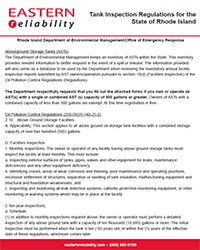Tank Inspection Regulations for the State of Rhode Island
Rhode Island Department of Environmental Management/Office of Emergency Response
Aboveground Storage Tanks (ASTs)
The Department of Environmental Management keeps an inventory of ASTs within the State. This inventory provides needed information to better respond in the event of a spill or release. The information provided will also serve as a database to be used by the Department when reviewing the mandatory annual facility inspection reports submitted by AST owners/operators pursuant to section 10(d) (Facilities Inspection) of the Oil Pollution Control Regulations (Regulations).
The Department respectfully requests that you fill out the attached forms if you own or operate an AST(s) with a single or combined AST (s) capacity of 500 gallons or greater. Owners of ASTs with a combined capacity of less than 500 gallons are exempt. At this time registration is free.
Oil Pollution Control Regulations (250-RICR-140-25-2)
2.10 Above Ground Storage Facilities
- Applicability; This section applies to all above ground oil storage tank facilities with a combined storage capacity of over five hundred (500) gallons.
- Facilities Inspection
- Monthly inspections; The owner or operator of any facility having above ground storage tanks must inspect the facility at least monthly. This must include:
- Inspecting exterior surfaces of tanks, pipes, valves and other equipment for leaks, maintenance deficiencies and any other equipment deficiency;
- Identifying cracks, areas of wear, corrosion and thinning, poor maintenance and operating practices, excessive settlement of structures, separation or swelling of tank insulation, malfunctioning equipment and structural and foundation weaknesses; and
- Inspecting and monitoring all leak detection systems, cathodic protection monitoring equipment, or other monitoring or warning systems which may be in place at the facility.
- Ten-year inspections;
- Schedule;
- In addition to monthly inspections required above, the owner or operator must perform a detailed inspection of any above ground tank with a capacity of ten thousand (10,000) gallons or more. The initial inspection must be performed when the tank is ten (10) years old, or within five (5) years of the effective date of these regulations, whichever comes later.
- Any tank which is of an unknown age must be inspected within five (5) years of the effective date of these regulations.
- If a tank is due for an initial inspection but has previously been inspected in a manner consistent with the criteria set forth, within a ten (10) year period to the due date, the Director may accept this previous inspection.
- Reinspection of all tanks is required no later than ten (10) years from the date of the previous inspection.
- Exemptions; Ten-year inspections are not required for the following unless otherwise specified:
- Tanks which are entirely above ground, such as tanks on racks, cradles or stilts are exempt from §§ 2.11(D)(2)(c)((1)) through ((5)) of this Part.
- Tanks storing No. 5 or No. 6 fuel oil or tanks storing asphalt products;
- Tanks installed in conformance with standards for new construction as set forth in §§ 2.11(I)(1) through (6) of this Part.
- Requirements for ten-year inspection; A ten (10) year inspection must consist of an appropriate tightness test of the tank and connecting piping or an inspection which consists of the following:
- Cleaning the tank in accordance with generally accepted practices;
- Removal, transportation and disposal of sludge in a manner, consistent with all applicable State and Federal laws and regulations;
- Inspecting the tank shell for soundness and testing all welds and seams on the tank bottom for porosity and tightness. The test must be consistent with accepted industry testing and inspection practices. This may include one or a combination of the following: a tightness test, an air pressure, hydrostatic or vacuum test, a penetrant dye test and a non-destructive test to detect thinning of the tank;
- Visual inspection of the internal surface of the tank for corrosion or failure;
- Inspection of internal coatings for any sign of failure of the coating system such as cracks, bubbles, blisters, peeling, curling or separation; and
- A tightness test of any connecting underground pipes.
- Schedule;
- Inspection reports;
- Reports for each monthly inspection and ten-year inspection must be maintained and made available to the Department upon request for a period of at least ten (10) years. An annual report, comprising the monthly inspection reports or a yearly summary and any ten-year inspection reports completed in the previous 12 months, shall be submitted to the Department of Environmental Management, Office of Emergency Response. Reports shall be submitted by December 31 of each year.
- The reports must include the following information:
- Identification number for tank(s) inspected;
- Date of inspection;
- Results of inspection, including specific inspection procedures any deficiencies and corrective actions;
- Certification by the inspector that the inspection has been performed in accordance with these regulations;
- Signature and address of the inspector.
- Monthly inspections; The owner or operator of any facility having above ground storage tanks must inspect the facility at least monthly. This must include:
Need Your Tank Inspected?
Eastern Reliability can provide primary tank inspection services and works with several regional partners to provide timely, economical, yet very detailed tank inspection services that will meet all regulatory requirements. Inspection personnel have the industry experience, all safety training and professional certifications required for inspectional services.
Please contact us to schedule your chemical tank inspection.
Need Your Tank Inspected?
Fill out our form below and we will contact you shortly to schedule a date for your chemical tank inspection.

